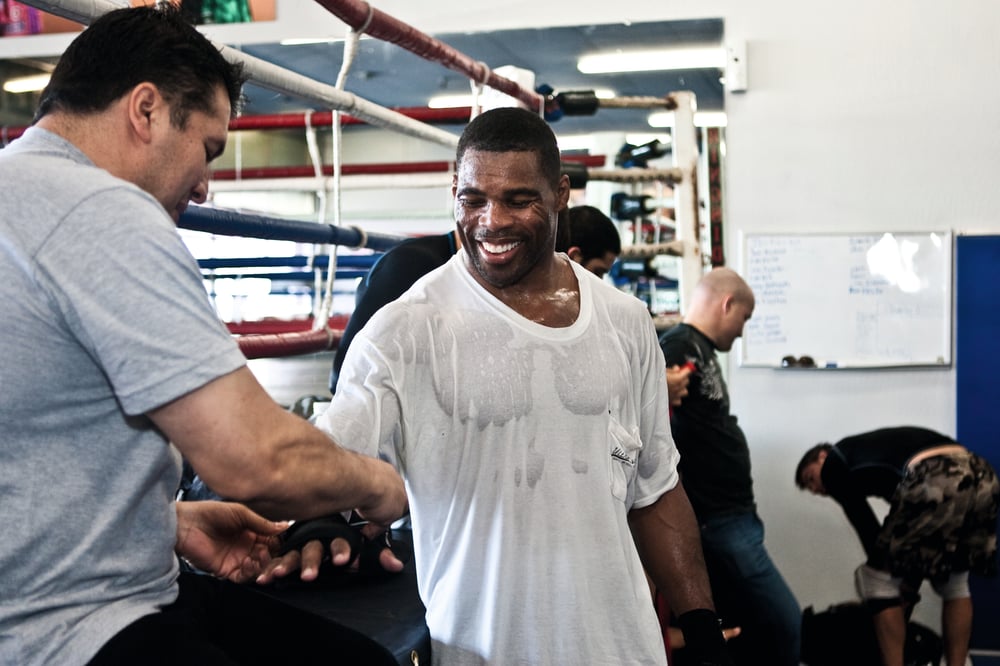
Issue 086
March 2012
How American Kickboxing Academy architect Javier Mendez came to create one of MMA’s most formidable fighting groups
Broken glass on the floor is the last thing a barefoot kickboxer wants to worry about when dedicating blood, sweat and tears to the gym.
LEADING MAN
JAVIER MENDEZ
AKA head trainer
It was a real concern in the old industrial training haunts of Javier Mendez, now the head trainer at the dominant American Kickboxing Academy, years before Bruce Willis immortalized his bloody steps in Die Hard. Sweeping up floors at a glass shop, Mendez, working as a bottler for Budweiser in San Jose’s blue-collar back roads in 1985, taught eager students what he knew. Mostly boxing, a little taekwondo and tang soo do, a Korean self-defense discipline.
Mendez loved competition growing up, yet didn’t participate. Becoming a pro fighter, champion or world-renowned coach to men like Cain Velasquez, Josh Koscheck, Jon Fitch, Daniel Cormier, Herschel Walker and Cung Le was never on the table.
“There was a sports presence in my heart, but there were financial issues – no backing – to get me involved in any sports, but I had love, and that was greater than anything I could ask for,” says Mendez, 52, as he sits just off the mats at the American Kickboxing Academy headquarters in San Jose, California. Opened in April last year, the new premises have enough square footage – 27,000 feet, three-times its previous location – to truly match its international reputation as an elite mixed martial arts gym. It’s a far cry from AKA’s humble pre-UFC 1 beginnings.
After high school and many failed attempts to break Coke bottles with nunchucks due to his Bruce Lee hero-worship, Mendez, who emigrated to the Bay Area from Mexico with his parents as a six-year-old, committed to martial arts, sparring for the first time with pro full-contact fighter Ed Perkins at 22 years old.
“I guess I beat him up and I didn’t realize I did,” he recalls. “He kicked me out of his gym. He was a ranked point kickboxing fighter.”
Mendez was officially run out of the gym because he trained at two schools. Perkins didn’t give him the option to stay (although he would have). Mendez later realized he was booted because he did too well. Enter the rogue glass shop training.
Scott Coker, future CEO of Strikeforce, let Mendez conduct night sparring inside his West Coast taekwondo gym. Mendez outgrew numerous facilities including what he affectionately calls the “dinosaur gym” preceding AKA headquarters. A cornerstone trainer in MMA, the world-conquering mixed-art sport didn’t exist when he started his combat sports journey – nor did he see the signs. Mendez was even unaware of other stand-up arts like Muay Thai until he was already a ranked contender.
“I just wanted to be the best that I could be in the sport that I chose that was available at that time,” he says. “If MMA was available at that time, I would have chosen that.”

Mendez was an unlikely candidate for kickboxing world champion too. Coker asked Mendez, who was assisting with production elements on Coker’s West Coast Promotions, if he would compete in an exhibition versus Bill ‘Superfoot’ Wallace. Mendez desperately wanted to back out because he was a talker – a shoulda-woulda-coulda kind of guy. A friend, Juan Alexander, presented a simple proposition: “Until you’ve done something, I don’t want to hear nothing.”
Mendez agreed to go through with it. He insists Superfoot carried him and by the end of the bout, observers believed Mendez had 10 fights under his belt instead of just one – the one witnessed. ‘Thunder’, as Mendez was known, left behind a Century 21 real estate job and went on to capture the light cruiserweight and light heavyweight world championships.
“I never considered myself one of the greats like Rick Roufus or Dennis Alexio. I attained my goal. I was the best I could be,” says Mendez. “I was a world champion. I attained that. I didn’t conquer the world.”
Mendez discovered the UFC through Paul Varelans in December 1995. By then Varelans was a veteran of both UFC 6 and 7 and had been introduced to audiences as a ‘trap fighter.’ Mendez fully involved himself the following year, however, thanks to Brian Johnston, who wanted to compete for Art Davie’s promotion. Mendez knew Davie through K-1 and put in a good word for Johnston – a fighter with enough size and looks, the UFC’s main concerns at the time – to enter the Octagon. Mendez asserts neither he nor Johnston knew what they were doing. AKA escalated into a respected MMA program in the mid-1990s when Frank Shamrock, a world-class catch wrestler, sought striking guidance.
BJ Penn, ‘The Prodigy’ of the jiu-jitsu world, followed suit and the gym’s stellar reputation skyrocketed, carrying on until a welterweight trio of Jon Fitch, Josh Koscheck and Mike Swick placed the three letters all over the UFC’s broadcasts during the early The Ultimate Fighter era. AKA crowned their first homegrown UFC champion, heavyweight Cain Velasquez, in 2010.
Despite Mendez’s deep roots in MMA, he defers pioneering status to the Gracies. They were doing it way before he was, insists AKA’s head trainer. He does, however, assert AKA’s consistency of quality.
AKA continues to evolve with the sport: from kickboxing center to original MMA gym to fight factory featuring world-class wrestlers like Muhammad Lawal and Daniel Cormier alongside one of MMA’s strongest fight rosters. Mendez’s headaches of juggling every-day training, rigorous fight schedules, cornering duties and moving parts involved in running an internationally renowned gym can’t be understated.
But it’s all worth it to Mendez, who operates on a simple premise that changed his life: AKA is not a shoulda-woulda-coulda place. AKA is a put-up-or-shut-up family.










